Out-of-Hospital Cardiac Arrest data linkage project: 2017-2018 results
Third report on Scottish Out-of-Hospital Cardiac Arrest (OHCA) data linkage project tracks key patient outcomes as strategy partners attempt to optimise implementation of the 'Chain of Survival' across Scotland.
Initial rhythm, Bystander CPR and Survival
Initial rhythm
The initial heart rhythm recorded on the ECG (Electrocardiogram) on arrival of SAS is significant. A patient may have a shockable rhythm (ventricular fibrillation or ventricular tachycardia), treated by delivering an electric shock using a defibrillator, or non-shockable rhythm (asystole or pulseless ventricular activity and bradycardia). The initial treatment and prognosis depends on presenting heart rhythm, with better survival after OHCA with shockable rhythm. In 2017/18, data was available for 93.4% of worked OHCA included in the linked dataset. A shockable initial rhythm was recorded in 25.2% of worked OHCA cases. Figure 4 shows how this compares with previous years.
Figure 4: Proportion of OHCA with shockable initial ECG rhythms
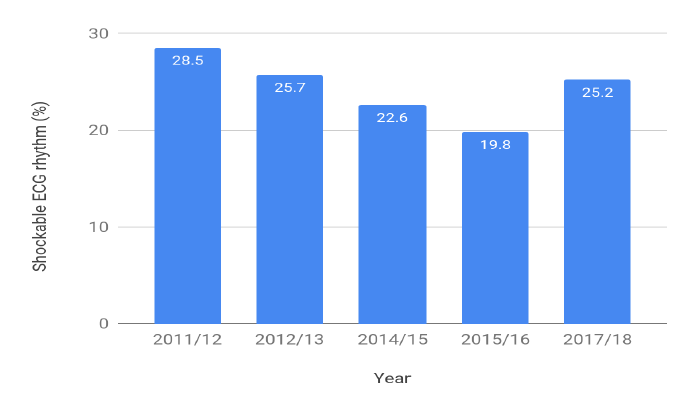
Figure 4: Shows the proportion of OHCA with a shockable initial rhythm (ventricular fibrillation or pulseless ventricular tachycardia) recorded on arrival of the Scottish Ambulance Service 2011/12 to 2017/18. Complete data for 2013/14 and 2016/17 was not available and is omitted.
Bystander CPR
Whether or not a member of the public performs chest compressions (CPR) on a patient while awaiting the arrival of the ambulance service is the most important modifiable factor determining survival after OHCA. Promoting bystander CPR is a key element of Scotland's Strategy for OHCA[1]. The proportion of OHCA with bystander CPR is therefore a very important metric for tracking progress. In 2017/18 bystander CPR was recorded as taking place on arrival of SAS personnel in 55.5% of cases. Figure 5 below shows the steadily increasing rate of bystander CPR since 2011/12.
Figure 5: Proportion of OHCA where bystander CPR was performed
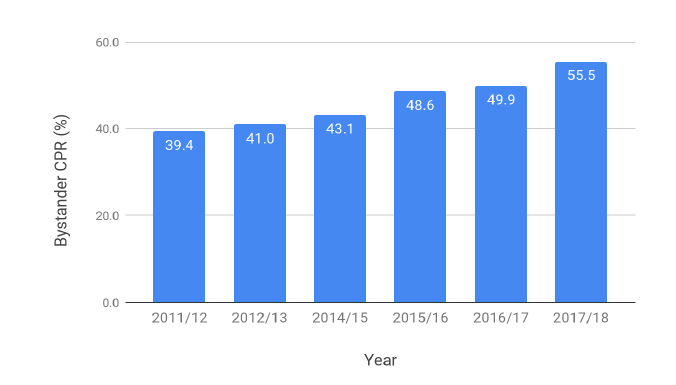
Figure 5: Shows the proportion of OHCA where bystander CPR was performed prior to the arrival of the Scottish Ambulance Service 2011/12 to 2017/18. Complete data for 2013/14 was not available and is omitted.
Figure 6 shows the proportion of arrests in each SIMD quintile who had an initial shockable rhythm and those who received bystander CPR in 2017/18.
Figure 6: Proportion of worked OHCA with shockable rhythm, bystander CPR, ROSC and 30-day survival for each SIMD quintile in 2017/18
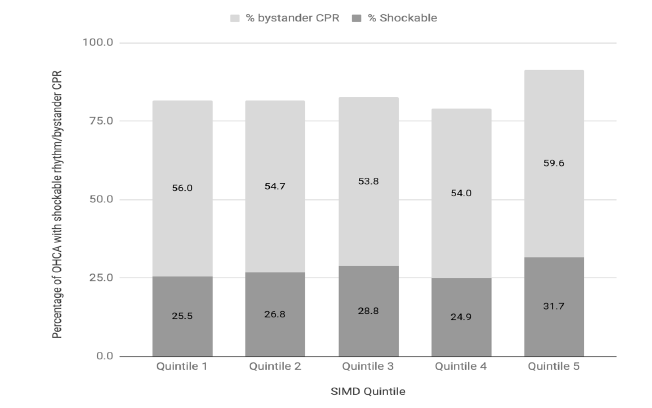
Figure 6: Shows the proportion of worked OHCA in each SIMD quintile who had a shockable initial ECG rhythm (dark columns) and who received bystander CPR (stacked lighter columns) in 2017/18.
ROSC and Survival
The key clinical outcome after OHCA is patient survival. This can be expressed in a range of ways. An important intermediate measure is Return of Spontaneous Circulation (ROSC). Definitions for ROSC vary. The Scottish Ambulance Service records ROSC if a patient regains a palpable pulse which is sustained until arrival at the Emergency Department. This is sometimes referred to as 'survival to hospital' or 'number of hearts restarted'. ROSC does not equate to survival. In this document we report an overall ROSC rate for OHCA, including shockable and non-shockable rhythms.
The definition of 'survival' used in this report is survival to 30 days after OHCA. We have defined survival as the proportion of worked OHCA where patients were still alive at 30 days. It is important to note that worked arrests which were not linked to outcome data have been assumed to be deaths and included in the denominator when calculating survival rates. This approach was taken deliberately to avoid over-inflation of survival figures, and is not universally adopted by groups reporting OHCA data. A more detailed discussion of the methodology we have used can be found here[2] [4]. In 2017/18 ROSC occurred in 23.3% of cases, while 8.3% of OHCA patients survived to 30 days. This is shown in Figure 7.
Figure 7: Proportion of worked arrests which had ROSC, and the proportion of people who survived to 30 days after OHCA
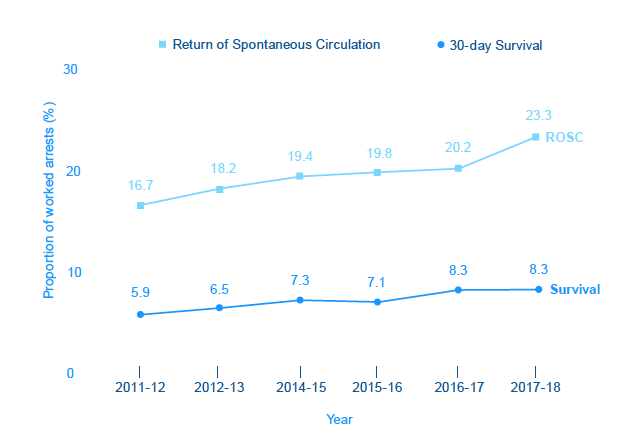
Figure 7: Shows the proportion of OHCA where the patient had a pulse on arrival at hospital (ROSC), and the proportion of OHCA patients who were alive at 30 days, 2011/12 to 2017/18. Complete data for 2013/14 was not available and is omitted.
Number of OHCA Survivors per million of the population
Another method of describing survival after OHCA is to measure the number of 30-day survivors per million of the population. The advantage of this approach is that it measures the actual number of survivors, and is less susceptible to variations in data interpretation which can skew the 'worked arrests' denominator when calculating the proportion of worked OHCA who survive to 30 days. Population figures for this calculation are derived from mid-year estimates from National Records of Scotland. Figure 8 shows the 30-day survival per million of the population and reported bystander CPR rates for all worked arrests from 2011/12 - 2017/18. Figure 8 has also been annotated to show key milestones in improving the Chain of Survival in Scotland, including the launch of the OHCA Strategy in March 2015.
Figure 8: Number of 30-day survivors after OHCA per million of the population and proportion of OHCA receiving bystander CPR
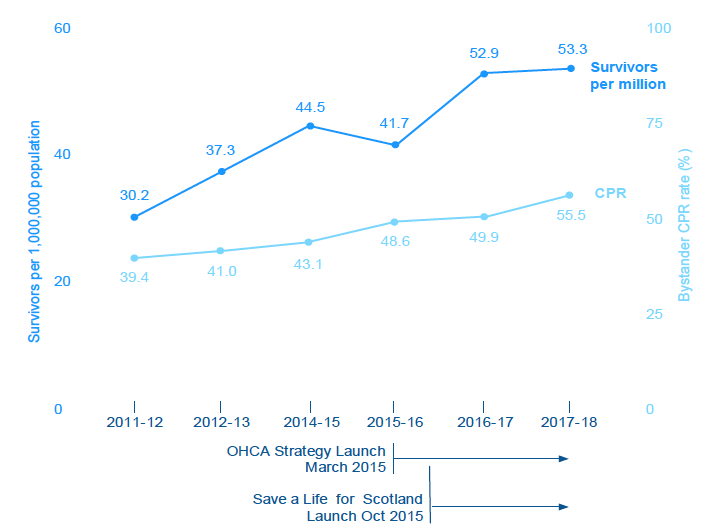
Figure 8: Shows the number of 30-day survivors per million of the population (dark blue line) and the rate of bystander CPR 2011/12 to 2017/8 (light blue line). Complete data for 2013/14 was not available and is omitted.
Contact
Email: Guy McGivern
There is a problem
Thanks for your feedback